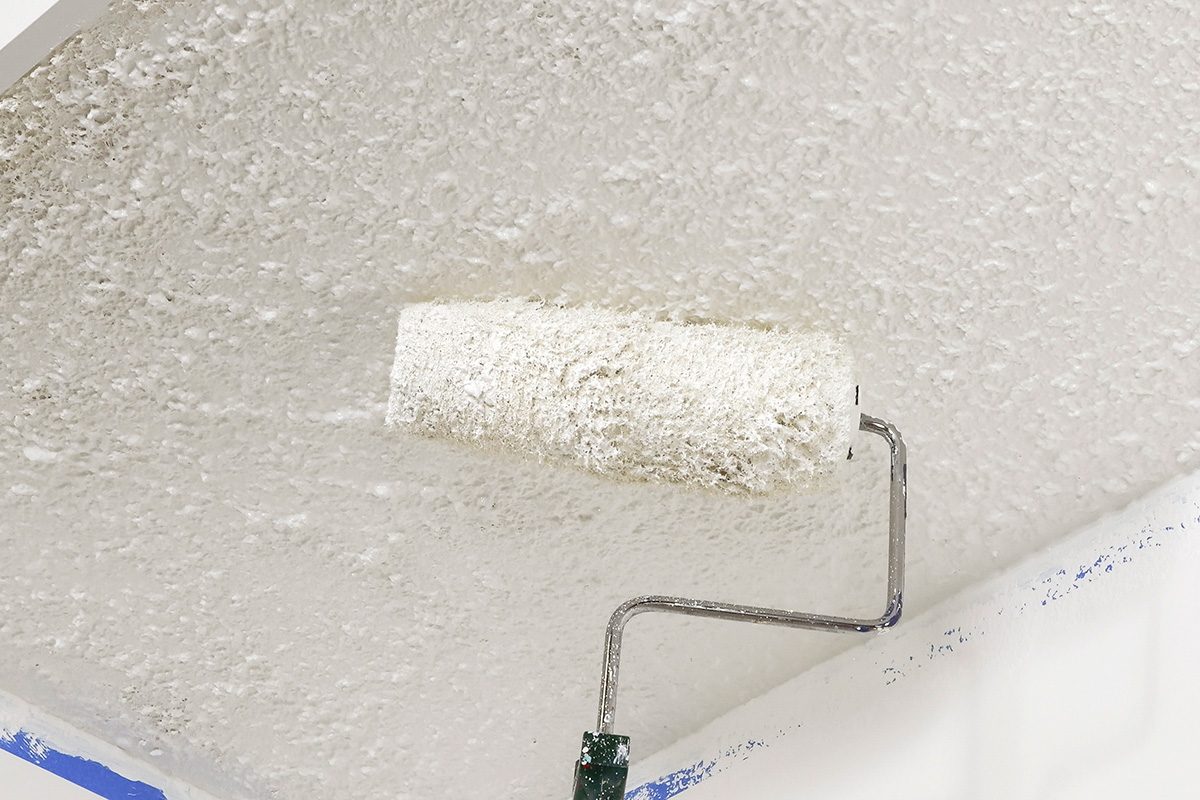A DIYer's guide to painting popcorn ceiling surfaces.
A full day
Beginner
Under $100
Introduction
Whether you're updating a room or tackling the whole house, this step-by-step guide will show you how to paint a popcorn ceiling like a pro.
Although smooth walls have been the trend for many years now, some homes still have popcorn or textured ceilings. As with all walls in your home, there will come a time when you may want to paint it. Since popcorn and textured ceilings capture and trap dust and grim, they can look dingy over time. Even when you try to clean them, they just don’t look fresh and crisp, and you come to the crossroads of deciding to paint them. Before moving forward with painting, carefully consider your long-term plans for the ceiling, as painting over popcorn texture will make it significantly more difficult and costly to remove in the future should you decide to do so.
Painting any textured or rough surface has its challenges and requires a bit more effort than painting a smooth surface. Most importantly, it requires the thickest nap roller you can find. If you have ever painted a rough or textured surface with a thin nap roller, you know how frustrating it can be. Here is the lay of the land when approaching a popcorn ceiling with paint.
Do popcorn ceilings have asbestos?
Popcorn ceilings or textured ceilings applied in the 1980s or earlier are likely to contain some amount of asbestos, which is known to cause cancer. If you’re not sure when your popcorn ceiling was installed, you can send a sample off to home centers to check if it contains asbestos. If uncertain, wear protective gear, such as safety glasses and a mask, to avoid coming into contact with crumbling texture or dust particles. If left undisturbed, the popcorn ceiling may be painted over, which is not harmful.
Tools Required
- Angled paintbrush
- Drop cloths or plastic tarps
- Paint roller
- Paint tray
- Paint tray liner
- Thick nap roller
Materials Required
- Ceiling paint
- Painter's tape
- Primer
Project step-by-step (6)
Mask the ceiling before painting
Before painting, clean the surface well to eliminate dust and loose particles. Dust and loose particles prevent the paint from properly adhering to any surface.
Use two-inch wide painter’s tape to mask off the edges of the outer perimeter of your ceiling. Ensure good adhesive bonding of the tape to seal the edge and avoid paint bleeds under the tape line. This is particularly important if the color of the walls differs from the color of the ceiling.

Protect floors and furniture with drop cloths
When using thick nap paint rollers, a lot of paint splatter will be generated during the painting process. Protect your floors and furniture with drop cloths or tarps to avoid paint droplets from getting everywhere. Additionally, wear clothes you won’t mind getting paint on, and protect your eyes by wearing safety glasses.
Cut in around the edges
Cut in around the edges of the room using a 1-1/2-to-2 in. angled trim brush to get into the nooks and crannies of the texture. Be generous when loading the brush with paint. Be careful not to push the paint too deeply into the tape’s edge, as this may cause it to bleed underneath. Use light brush strokes to avoid disturbing or damaging the texture.
Tip: Textured painter’s tape will leak paint through the wrinkles and under the texture, resulting in paint bleed that requires touchups. Choose painter’s tape with the smoothest texture for a clean paint edge.

Painting popcorn ceiling
Ceilings are usually painted in a flat finish unless they are located in high-moisture areas, such as bathrooms. Using a generous amount of paint, roll the paint onto the ceiling in random directions. Crisscross the roller as you go to force paint into the crevices of the texture. Think of making X and W patterns with your roller movement. In areas where a paint roller is too cumbersome to operate, use the trim brush to force the paint into the deep pockets of the popcorn drywall texture.
If you splatter paint on something not protected by a dropcloth, try to clean it up before the paint has fully dried. The fresher the paint splatter droplets, the easier they will be to remove.
Allow the paint to dry and apply a second coat. In most cases, two coats are sufficient, but depending on the coarseness of your ceiling and the paint you choose, more coats may be required.
Tip: Ceilings are usually painted white or light colors to reflect light back into the room. A darker paint color will absorb the light – which may be a conscious choice for a space such as a home theater.

Remove the painter’s tape and clean up
Once the paint has dried, gently remove the painter’s tape used to mask off the edges. Be careful not to pull off the texture that has been bonded to the edge of the tape. Remove the drop cloths and clean your painting supplies.
FAQ
Can I use a paint sprayer on a popcorn ceiling?
You may consider using a paint sprayer to paint a popcorn ceiling. This will save on actual paint time but will require a lot more prep time. Using a paint sprayer will require the whole room to be fully protected because of the large amount of overspray. It comes down to personal preference. Ask professional painters, and half will say, “Definitely use a brush and roller,” and the other half will say, “Definitely use a paint sprayer.” For me, it comes down to the configuration of the room: how much furniture is in there? What is the surface of the floor? How tall are the ceilings? The right choice is the one you feel most comfortable with.
What if I don’t want to paint a ceiling white?
White is highly reflective of light and will help a room feel bigger. If you want a bit of color but not a stark white, some professionals will mix a ratio of white with the color being used on the walls, so the ceiling lends itself to a complementary color but isn’t stark white. Be sure to do a test, focusing on the color when it is dry. Wet paint is deceiving because it is usually a different color than when it is dry. Think of saving a small amount of the mixed paint or make a note of the ratio used in the mix should you need to touch it up in the future.
What type of paint should I use for the ceiling?
More often than not, especially in new construction, you will find a ceiling painted with primer and no additional topcoat. If you desire a specific color match, you may add a topcoat over the primer.
Paint manufacturers are now selling paint specifically designed for ceilings. The difference between ceiling paint and primer is that ceiling paint is thicker, which may make additional coats less necessary. Ceiling paint comes in flat or low-gloss sheen.
Both primers and ceiling paints are manufactured to be stain-resistant, which means they are less likely to absorb smoke, cooking vapors, and other substances. Both ceiling paint and primers are also mildew-resistant.



















